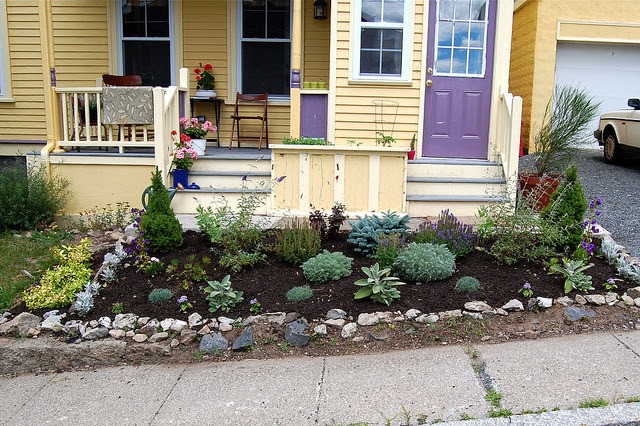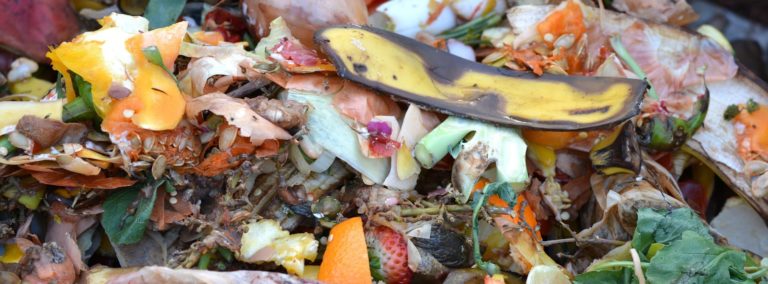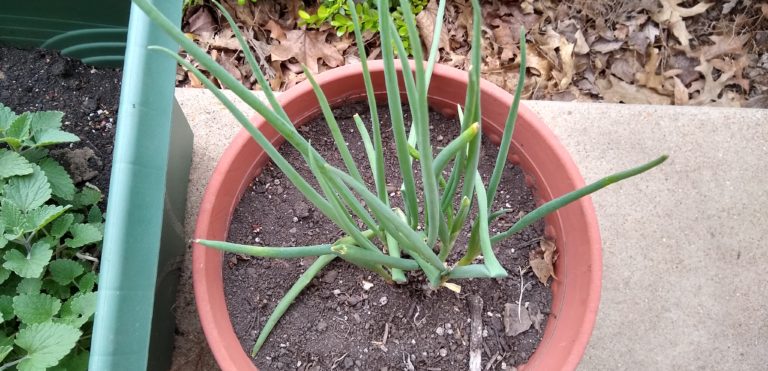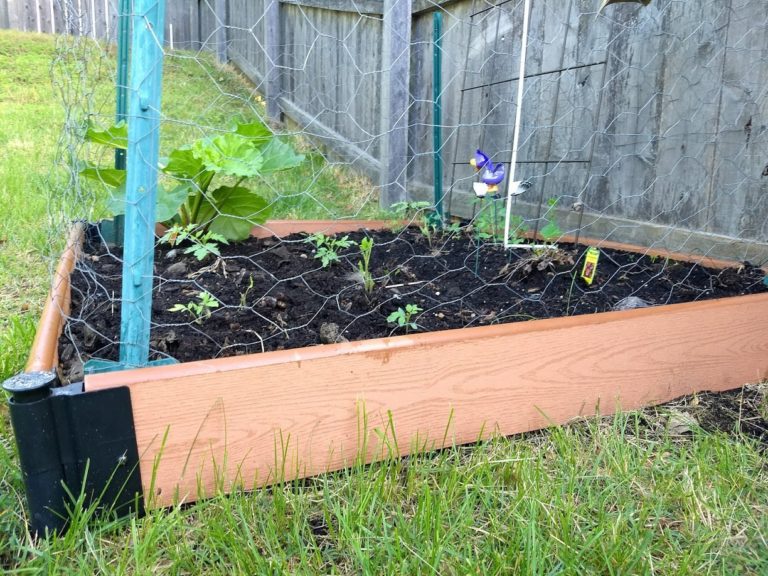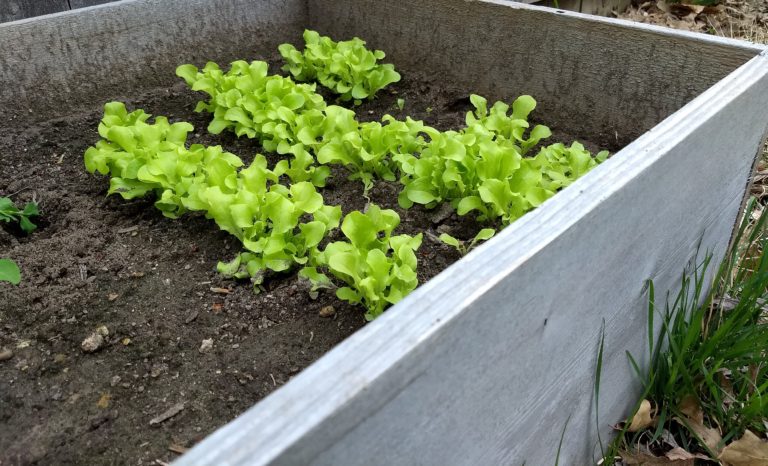Why You Should Grow Food in Your Front Yard
Vegetables belong only in back yard gardens, right? Maybe not.
Depending on where you live, some cities or homeowners associations do not allow food to be grown in front yards. Yet it’s becoming more common in many areas to see home owners making use of all of their real estate for garden edibles, and not just the back yard. More people are also becoming aware of the financial and environmental pitfalls of maintaining a traditional lawn and have a desire to grow something more useful and eco-friendly.
If you can do it, you might want to consider growing food in your front yard. And honestly, it’s likely no one will notice if you tuck a few pepper plants in among your boxwoods, so start small if you have concerns about the neighbors or local laws.
Reasons for growing food in your front yard:
- Growing food in your front yard maximizes available growing space, so you can grow more food.
- You may not be able to grow food in your back yard because of excessive shade, a steep slope, small size, or because your back yard is filled with other things such as a swing set or pool.
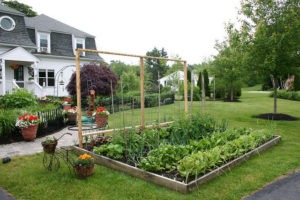
I began growing tomatoes in pots on my front porch a few years ago. Much of my back yard is sloped and has limited sun, and for several years a critter had been stealing every last one of my tomatoes from my back garden while they were still green. The back yard was neither a hospitable nor a safe place for tomatoes.
My spacious front porch, however, gets full sun all morning and through much of the day. I bought two large pots, filled them with potting soil, and set my newly purchased tomato plant seedlings in them. As the plants grew, I added a tomato cage around each to keep them from sprawling. Once they really began to grow, it wasn’t long before the neighbors began asking in tones of surprise and admiration: “Are those tomatoes on your front porch?”
I still lost a few green tomatoes to squirrels or other varmints, but the front yard sees more foot and vehicle traffic and has fewer places for thieving critters to hide, so it was all together a better environment for my tomato plants. I also watered my plants more frequently because I saw them during my daily comings and goings from the house and remembered to tend to them.
In the years since, I’ve also grown pots of mint, nasturtiums, bell peppers, and asparagus seedlings on my front porch. While most people consider nasturtiums to be decorative only, the flowers are edible, so this plant counts as growing food in my front yard as well.
I’ve noticed a slowly growing similar trend when I go walking in my neighborhood. One woman has tomato plants growing directly in landscaping beds in her front yard. Another family has a spread of pots on their large, sunny front porch that includes squash, cucumbers, peppers, onions, and tomatoes. Not long ago, one of my other neighbors grew a tomato plant using something like a Topsy Turvy tomato plant holder on her front porch, where someone might typically hang a flower basket.
Some methods for growing food in your front yard or on your porch are better than others. Obviously, you may not be ready or able to rototill a large square of earth in the middle of your front lawn and create a traditional row garden. Overall, you probably want to go for a tidy, maintained, somewhat manicured look.
Tips for Growing Food in Your Front Yard:
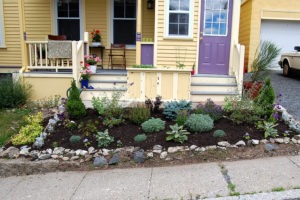
- Plant your edibles among the rest of your landscaping. The goal is to mix and blend your veggies and regular plants. It’s okay to mix flowers with vegetables in a front landscape bed. Some people who walk by your house may not even notice the veggies if they’re admiring all the flowers. So go ahead and plant green beans next to the petunias. Don’t feel like you have to plant only in neat rows either. If pre-existing landscape beds have curved borders, plant in curves and waves as well.
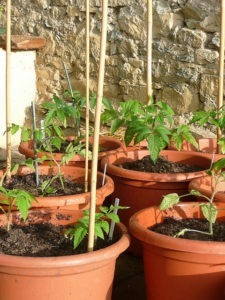
- Go the container garden route. Pots and other containers naturally give a space a more well-tended look. You can go with basic terra cotta pots, or invest in decorative pots for a more upscale look. I recommend buying larger pots because they retain more water, reducing the amount of daily watering you’ll need to do. Containers can easily be moved and stored elsewhere during the off season, which improves the look of your front yard and keeps things tidy, but don’t be limited to traditional pots either. If you have room — particularly if you have a large, sunny porch — consider buying a large square or rectangular planter almost like a small raised bed. You can find many of these types of containers online. You’ll maximize your growing space.
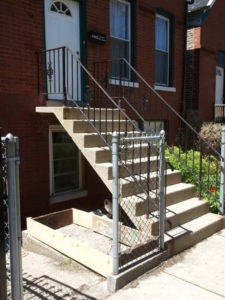
- Consider using raised beds. Raised beds in the front yard aren’t for everyone, but there are a lot of nice wood kits (including some with decorative edges and corner posts) in home improvement stores and online these days for reasonable costs, or look online for directions on how to make your own raised beds. Beds can be made of wood, stone, bricks, concrete blocks, and more. Raised beds generally have fewer weeds and help to keep your plants contained. If you have a good spot in your front yard, consider adding a raised bed or two. One of my neighbors has a square wood raised bed positioned at a diagonal angle in his front yard so it looks like a diamond. In addition to plants, he placed a bird bath and some solar lights in the bed, so the bed becomes a decorative feature in the front yard. Also, if you make your own compost, you’ll have an inexpensive way to fill your raised bed with growing medium.
- Keep it as weed-free as possible. Just as you would with a traditional flower bed, don’t let your food garden go. It’s never pretty, and especially not in a front yard. This blogger encourages you to keep your front garden beautiful so it does not draw complaints. If you’re using primarily containers or raised beds, you’ll generally deal with fewer weeds, too.
- Keep things staked, propped, tied, or otherwise contained and supported. It’s easy for tomatoes to ramble all over the place, but the neighbors might not appreciate the aesthetics. Using tomato cages, stakes, and other methods goes a long way toward keeping that tidy appearance that adds to a home’s curb appeal.
- Enrich the soil. If you’re growing in landscaping beds or otherwise planting veggies and fruits directly in the ground, provide a little TLC. Add some Miracle-Gro or, better yet, homemade compost to create an ideal growing environment.
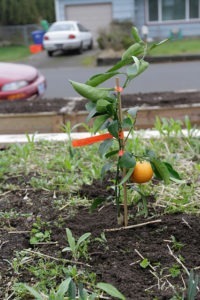
- Try a fruit tree. If you aren’t ready to break front yard stereotypes by planting green beans and tomatoes, start with something less shocking like a fruit tree. Plant something that will grow well in your region.
- Protect your harvest against passerby who may be tempted to help themselves. During a visit to Chinatown in Chicago a few summers ago, while walking through a residential area, I noticed a resident had a pear tree growing against the iron bar fence at the front of his courtyard, right next to a well-trafficked sidewalk. He had installed wood latticework and netting to prevent passing pedestrians from reaching through the fence bars and plucking the results of his hard work. When you grow food in your front yard and it’s easily visible to others, you may want to make it as difficult as possible for people to steal your hard-earned fruits and vegetables. And you thought gardeners only had to contend against rabbits and deer, right?
Do you grow any vegetables, herbs, or fruit in your front yard? What do you grow? What have your neighbors’ responses been? Let us know in the comments!

